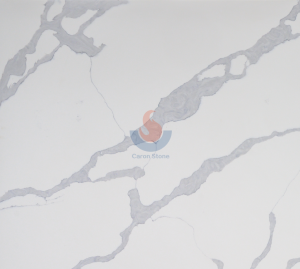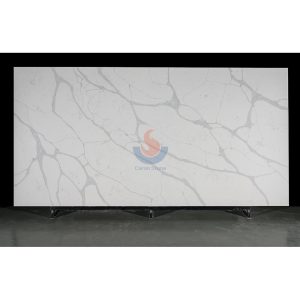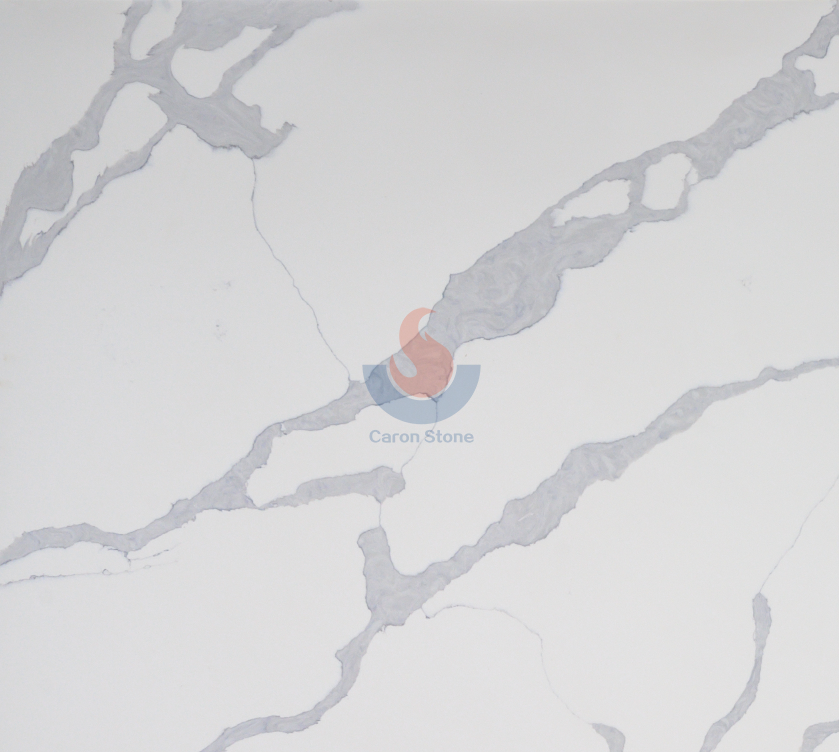In the sphere of modern architecture and home design, the choice of materials represents the quest of quality of life as much as beauty and utility. Excellent performance and environmental protection qualities of quartz slabs have helped them to progressively take front stage on the market. The definition, raw materials, manufacturing technique, and extensive use of quartz slabs in many sectors will be discussed in this article, so highlighting how this material shines in current design.

Calacatta White Artificial Quartz 46
What is quartz slabs
Quartz slabs are also called artificial quartz stone. Artificial quartz stone is a type of synthetic stone. Designed artificially by more than 80% quartz crystals with resin and other trace materials, this is a new kind of stone. Pressed under specific physical and chemical conditions, this large-sized plate comes from a sophisticated machine. It can be tailored to fit the many needs of clients. Cut according to certain criteria into several sizes and designs.
Raw materials of quartz slabs
Made of crushed quartz sand particles and powder, quartz slabs can be ornamented with glass, lens, ceramic, glass, shell, pieces. Made of polymer (unsaturated polyester resin) or inorganic adhesive (cement) as bonding materials, they are cured, distributed, coupled, and other additives (slurry), mixed with pigments, and formed by stirring, vacuum, high pressure, high frequency vibration, and then either room temperature or medium temperature. To get the required finished slabs, the material is synthesized by means of thickness setting, polishing and processing.
The five main characteristics of quartz slabs are derived from their great hardness and temperature resistance, which define quartz sand as the aggregate of these slabs:
1. Scratch-proof (Mohs hardness 7);
2. Not polluted (dense, non-porous; vacuum manufacturing);
3. Not scorched; rather, resistant to 300℃;
4. Not worn out (30 polishing processes without maintenance);
5. Non-toxic and non-radiative (NSF certified, does not contain heavy metals, and can be in direct contact with food).
Production process of quartz slabs at home and abroad
Mostly involving raw material weighing, mixing, spreading, pressing, curing, unloading, deep processing thickness determination, polishing and cutting, the manufacturing process of fake quartz slabs both at home and abroad is rather consistent. Two production lines—the grinding line production line and the pressing line production line—complete the manufacturing of artificial quartz goods mostly.
1. Pressing line manufacturing line
The pressing line production line mostly consists in weighing area, mixing area, spreading area, pressing area and curing area. Pressing line production line process flow: weighing-mixing-spreading-pressing-curing.
2. Line production line grinding
Usually running through grinding equipment to convert the rough surface of the raw board into finished large plates with various brightness, the grinding line production line mostly employs different tools and abrasives. The grinding line production line’s process flow is thickness determining-polishing-cutting.
Applying performance
Most of the quartz goods available on the market solve the disadvantages of natural stone that is non-renewable, low stain resistance, and may be radioactive; they are wear-resistant, scratch-resistant, heat-resistant, and corrosion-resistant.
Quartz slabs’ excellent performance qualities make them extensively employed in cabinet counters, bathroom counters, window counters as well as upscale public areas and entertainment venues. Cabinet counters in affluent nations are nearly entirely composed of quartz, and its many indications often exceed those of tiles and natural stones. Second, airports, subway stations, luxury office complexes and business plazas also heavily feature quartz.

Calacatta White Quartz 47
Nowadays, as inorganic quartz materials with great hardness, wear resistance, fire resistance, weather resistance, and other attributes become more and more used in engineering projects, depending on their environmental and health aspects. It can be customized with regard to subways, stations, hospitals, and other locations as well as building exterior wall decorating. Consequently, the concentration of quartz sand will show a rising tendency year by year.





